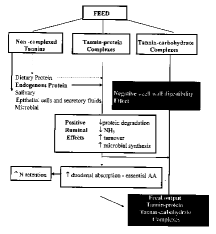In ruminants, tannins can induce beneficial effects. For example,
- In sheep and cattle higher retention of nitrogen has been observed in sheep and cattle with low to moderate levels of tannins in forages,
- In these cases, the lower apparent and true digestibility of nitrogen was compensated for by reduced urinary loss of hydrogen,
- Moderate levels of tannins (less than 4% ) in forage legumes can have beneficial responses in ruminants, resulting in higher growth rates and milk yield,
- However, even in ruminants, levels of tannins exceeding 6% of the diet result in negatively affect growth rates and milk yield.
Several mechanisms have been suggested to explain how tannins influence protein utilization by ruminants –
Rumen escape
One mechanism postulated is that tannins complex proteins at the pH of the rumen (5 to 7) and protect them from microbial enzymes. Subsequently, these complexes dissociate in contact with gastric (pH 2.5-3.5) and pancreatic (pH 8) secretions.
- High quality dietary proteins would be protected, at least in part, from degradation in the rumen and would then be digested more effectively in the intestine.
Urea recycling
Another hypothesis is that tannins may increase efficiency in nitrogen recycling to the rumen.
Some facts –
- Tannins lower the rate of protein degradation and deamination in the rumen resulting in lower rumen ammonia concentration.
- This results in lower plasma urea nitrogen (PUN).
- Lower PUN means lower urinary nitrogen excretion with less wastage of nitrogen.
- Larger amounts of nitrogen are recycled because tannins stimulate increased saliva production.
Microbial efficiency
In diets based on tanniniferous forages, nitrogen rumen outflow is often larger than nitrogen intake. Several studies have reported an increase in protein flow when moderate doses of tannins were used. This has been attributed to –
- increased rumen escape of dietary proteins,
- increase in microbial protein flow (up to 28% in sheep).
The larger microbial flow could be the result of
- Increased saliva production, increased rumen turnover rate, and hence, increased microbial outflow,
- Increased nitrogen recycling to the rumen,
- Decreased proteolysis and slower fermentation of proteins and non-protein nitrogen in the rumen (particularly important in legume silages); this results in a more even nitrogen availability to bacteria.
Microbial flow is usually measured using a microbial internal marker (diaminopimelic acid, DAPA). However, tannins may reduce the extraction of microbial cells walls from digesta and make microbial flows measured with DAPA unreliable.
